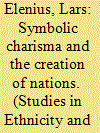| Srl | Item |
| 1 |
ID:
157402


|
|
|
|
|
| Summary/Abstract |
When I was a child growing up in Hammerfest, a small coastal town in the north of Norway, my family would take regular trips to our cabin in the northern hamlet of Skaidi. On the way there, we would always drive past “Stallo,” a huge, pointy rock that my mother would ask my brother and I to greet. This was very important, she told us, if we wanted good luck on our journey. I learned later in life that stallo is the Sámi word for “troll.” Back then, I had no idea that “Stallo” had its origins in the Sámi language, but then again, I didn’t know at that time that I too had Sámi origins.
|
|
|
|
|
|
|
|
|
|
|
|
|
|
|
|
| 2 |
ID:
152788


|
|
|
|
|
| Summary/Abstract |
This article examines the implications of undertaking community-based impact assessment (CBIA) in the Swedish context where Indigenous rights receive little recognition and the institutional planning environment is disenabling. It explores how normative biases built into the permitting process for mines ontologically privilege non-Indigenous ways of defining what constitutes relevant impacts. We show how the CBIA, undertaken by an impacted Sami community together with the authors, attempted to challenge these biases by constructing narratives about future impacts from the perspective of the Indigenous community. We also discuss how the research itself became embroiled in contestations over what constituted legitimate knowledge.
|
|
|
|
|
|
|
|
|
|
|
|
|
|
|
|
| 3 |
ID:
104201


|
|
|
|
|
| Publication |
2010.
|
| Summary/Abstract |
The cultural charisma of the Sámi people has served to inscribe them in the nation myths of the Scandinavian states. This charisma was also built into the self-image of the Nordic countries when they established as a political organisation in the 1950s. While this charisma was to some extent created by leaders of the majority population, its symbolic value has also been used by the Sámi movement as a tool for political mobilisation. The global resistance by indigenous people towards colonialism resulted in a shift of the Sámi people's strategy from national to global action, and in the redefinition from a 'nature people' within the nation-state to an 'indigenous people' in a global legalistic discourse. At the same time, Sámi politicians strive to unite the different Sámi groups through a common homeland, Sápmi, which crosses the nation-state borders. The political territory of Sápmi can culturally be regarded as an imagined nation in the same way as a nation-state, even if it is scattered across four countries. The creation of a Sámi nation also faces the same kind of inter-ethnic problems as the nation-state.
|
|
|
|
|
|
|
|
|
|
|
|
|
|
|
|